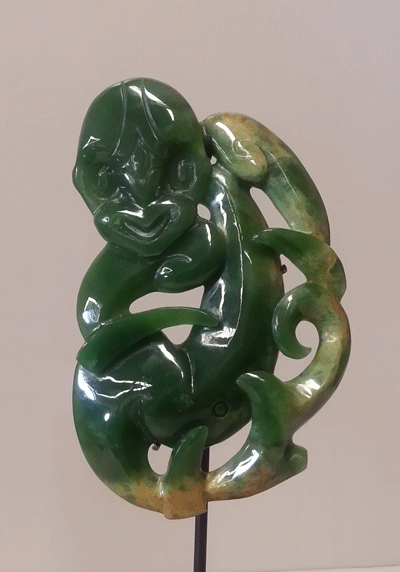Pounamu. New Zealand's national treasure.
New Zealand jade is known by its Maori name, Pounamu. The Maori migrated to New Zealand in the fourteenth century and soon discovered jade. They used it for toolmaking, weapons and adornment. When Europeans arrived centuries later with their knowledge of metal working it was the beginning of the end of this stone based culture. But jade carving did not disappear entirely and there is now a thriving jade industry in New Zealand, spearheaded by some very talented artists of both Maori and European descent.
Jade is only found on South Island but it is carved all over New Zealand. Hokitika on South Island and Rotorua on North Island are two places where highly talented carvers have their workshops. Hokitika is a small relaxed town with wide streets and friendly people. There are a number of jade carving studios where you can watch jade being carved. A lot of the carving is aimed at tourists. Not all of the jade is authentic New Zealand Greenstone or Pounamu. This is increasingly difficult to get hold of which means much of the jade is now imported from places like New Zealand. A lot of it is carved in factories in China.
Hokitika
Cutting room in one of the larger Hokitika jade workshops
Jade has spiritual significance for the Maori. Here are some of the most popular carvings based on Maori culture.
Hei Tiki
In Maori, Tiki, represents ancestors. As it is passed from generation to generation its spiritual value grows. The Hei Tiki should be worn around the neck and rest against the throat.
Toki
The Toki or Adz was originally used as a cutting tool but became a treasured ceremonial item handed down through the generations. A Toki symbolizes strength and courage.
Fish Hook/Hei Matua
Twist
Fish Hook. To give someone a jade fish hook means you wish them prosperity and good health. It also represents strength and determination and is seen by many people as an amulet to bring good luck in life. It can also give safe passage over water.
The Twist represents a new friendship or relationship. It is a very special gift to give to a friend. Many people mistake this for a traditional Maori design although it is relatively recent. It was introduced by a European carver in the second half of the twentieth century and has become a staple of the New Zealand carving industry. The one illustrated is a single twist although the more complicated double twist is equally popular.
Manaia
The Manaia has supernatural powers. It has the head of a bird, the body of a man and the tail of a fish. It represents the balance between the sky, earth and sea. It protects the wearer from evil
Kouru
The Kouru design is based on the fern frond. It represents new beginnings, growth and harmony. It can also express the promise of a meaningful relationship.







